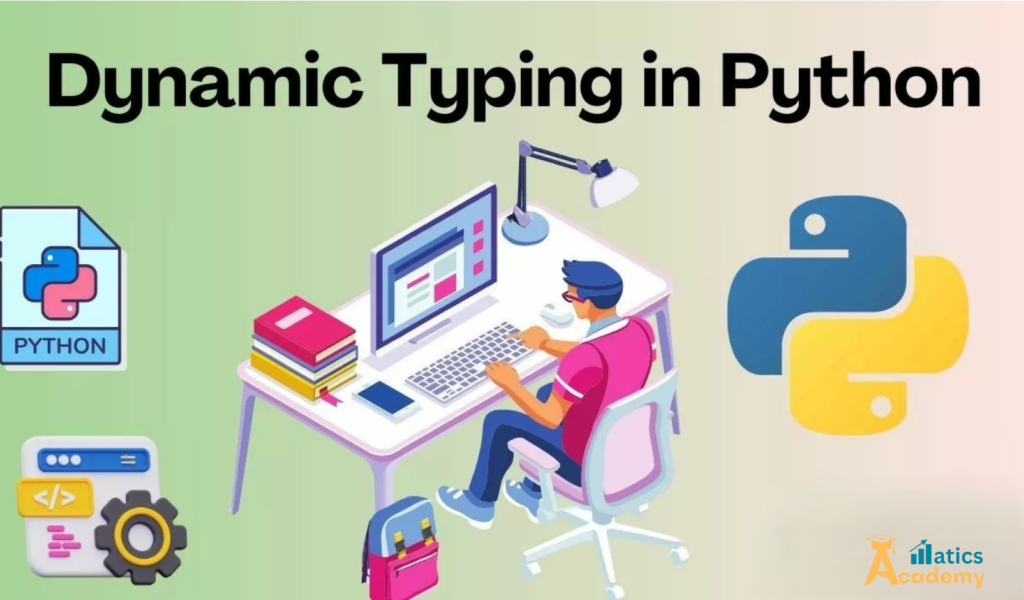Introduction to Dynamic Typing in Python
Python is a dynamically typed programming language, meaning that variable types are determined at runtime rather than being explicitly declared. This flexibility allows developers to write concise and adaptable code without worrying about defining variable types beforehand. Understanding dynamic typing can help you harness this flexibility effectively.

In contrast to statically typed languages like C++ and Java, where variable types must be explicitly declared, Python assigns types to variables dynamically, enabling rapid development and ease of use.
Understanding Dynamically Typing
In Python, when a variable is assigned a value, its type is automatically inferred. The same variable can hold different data types at different points in the program.
Example:
x = 10 # x is an integer print(type(x)) x = "Hello" # x is now a string print(type(x)) x = 3.14 # x becomes a float print(type(x))
Here, x initially holds an integer, then a string, and finally a float. Python dynamically updates its type based on the assigned value.
Advantages of Dynamically Typing
1. Ease of Use – No need to declare variable types, making the code more readable and concise.
2. Flexibility – The same variable can hold different data types, allowing for greater adaptability in code.
3. Faster Development – Developers can write code quickly without worrying about type constraints.
4. Less Boilerplate Code – Reduces the need for extensive type annotations.
Disadvantages of Dynamic Typing
1. Runtime Errors – Type mismatches can occur at runtime, leading to unexpected behavior.
2. Performance Overhead – Since types are determined at runtime, execution can be slower compared to statically typed languages.
3. Debugging Complexity – Bugs related to unintended type changes can be harder to trace and fix.
Type Checking in Python
Even though Python is dynamically typed, it provides functions like type() and isinstance() to check variable types at runtime.
Example:
y = 42
if isinstance(y, int):
print("y is an integer")
else:
print("y is not an integer")Using isinstance(), we can check if a variable belongs to a particular data type before performing operations on it.
Static Typing in Python with Type Hints
Python introduced type hints in PEP 484, allowing developers to optionally specify variable types while still benefiting from dynamic typing.
Example:
def add(a: int, b: int) -> int:
return a + b
print(add(2, 3))Although Python does not enforce type hints at runtime, they improve code readability and help with debugging and static analysis using tools like mypy.
Comparison: Dynamic vs Static Typing
| Feature | Dynamic Typing (Python) | Static Typing (Java, C++) |
|---|---|---|
| Type Declaration | Not required | Required |
| Flexibility | High | Low |
| Performance | Lower (runtime check) | Higher (compile-time check) |
| Error Detection | Runtime | Compile-time |
Python’s dynamic typing allows for flexibility but at the cost of runtime safety. Statically typed languages, on the other hand, ensure type safety at compile time but require explicit declarations.
Conclusion
Python’s dynamic typing simplifies programming by allowing variables to change types at runtime. While this makes coding easier and faster, it can lead to runtime errors if not handled properly. Developers can use type hints to improve readability and detect type issues early. Understanding dynamic typing will help you write more efficient and error-free Python programs.
Experiment with dynamic typing in your own Python projects to see its benefits in action!
Additional Topics:
Interview Questions:
1. What is dynamic typing in Python?(TCS)
Answer:
Dynamic typing in Python means that the type of a variable is determined at runtime, not at the time of declaration. Unlike statically typed languages (such as Java or C++), where the type of a variable must be explicitly defined, Python allows variables to change their type during execution.
2. How does dynamic typing affect memory management in Python?(IBM)
Answer:
Dynamic typing impacts memory management in Python because Python automatically allocates and deallocates memory using Garbage Collection. Since variables can change types at runtime, Python stores objects in heap memory and keeps track of them using reference counting.
If an object is no longer referenced by any variable, Python’s Garbage Collector (GC) removes it to free up memory. However, this flexibility can lead to increased memory consumption if objects are not properly handled. To optimize memory usage, developers use techniques like:
- Using generators instead of lists for large data
- Clearing unused variables with
del - Using memory profiling tools like
objgraphandgc
3. How does dynamic typing impact performance compared to statically typed languages?(Google)
Answer:
Dynamic typing in Python can lead to slower performance compared to statically typed languages like C or Java because:
- Extra Type Checking at Runtime: Since Python determines variable types dynamically, it performs type checks at runtime, which adds overhead.
- Interpreted Execution: Python is interpreted, meaning every operation needs to be verified dynamically, making execution slower.
- Memory Overhead: Python’s flexibility results in higher memory usage due to additional metadata associated with each object.
However, developers often accept this trade-off in applications where development speed and flexibility matter more than raw performance. In performance-critical applications, developers use tools like Cython or NumPy, which rely on optimized C implementations, to improve execution speed.
Take Quize😊
Question
Your answer:
Correct answer:
Your Answers
